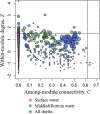The water depth-dependent co-occurrence patterns of marine bacteria in shallow and dynamic Southern Coast, Korea
- PMID: 31235719
- PMCID: PMC6591218
- DOI: 10.1038/s41598-019-45512-5
The water depth-dependent co-occurrence patterns of marine bacteria in shallow and dynamic Southern Coast, Korea
Abstract
To investigate the interactions between bacterial species in relation to the biotic and abiotic environmental fluctuations, free-living (FL), nanoparticle-associated (NP), and microparticle-associated (MP) bacterial community compositions (BCCs) were analyzed. A total of 267 samples were collected from July to December 2016 in the dynamic and shallow southern coastal water of Korea. The variations in BCC mostly depended on planktonic size fraction. Network analysis revealed water depth-dependent co-occurrence patterns of coastal bacterial communities. Higher interspecies connectivity was observed within FL bacteria than NP/MP bacteria, suggesting that FL bacteria with a streamlined genome may need other bacterial metabolites for survival, while the NP/MP copiotrophs may have the self-supporting capacity to produce the vital nutrients. The analysis of topological roles of individual OTUs in the network revealed that several groups of metabolically versatile bacteria (the marine Roseobacters, Flavobacteriales, Desulfobacterales, and SAR406 clade) acted as module hubs in different water depth. In conclusion, interspecies interactions dominated in FL bacteria, compared to NP and MP bacteria; modular structures of bacterial communities and keystone species strongly depended on the water depth-derived environmental factors. Furthermore, the multifunctional, versatile FL bacteria could play pivotal roles in dynamic shallow coastal ecosystems.
Conflict of interest statement
The authors declare no competing interests.
Figures






Similar articles
-
Seasonal succession of microbes in different size-fractions and their modular structures determined by both macro- and micro-environmental filtering in dynamic coastal waters.Sci Total Environ. 2021 Aug 25;784:147046. doi: 10.1016/j.scitotenv.2021.147046. Epub 2021 Apr 20. Sci Total Environ. 2021. PMID: 33894601
-
Unique microbial module regulates the harmful algal bloom (Cochlodinium polykrikoides) and shifts the microbial community along the Southern Coast of Korea.Sci Total Environ. 2020 Jun 15;721:137725. doi: 10.1016/j.scitotenv.2020.137725. Epub 2020 Mar 6. Sci Total Environ. 2020. PMID: 32182460
-
Spatiotemporal variations, assembly processes, and co-occurrence patterns of particle-attached and free-living bacteria in a large drinking water reservoir in China.Front Microbiol. 2023 Jan 19;13:1056147. doi: 10.3389/fmicb.2022.1056147. eCollection 2022. Front Microbiol. 2023. PMID: 36741896 Free PMC article.
-
Effects of shallow-water hydrothermal venting on biological communities of coastal marine ecosystems of the western Pacific.Adv Mar Biol. 2006;50:267-421. doi: 10.1016/S0065-2881(05)50004-X. Adv Mar Biol. 2006. PMID: 16782453 Review.
-
Zooming in on the phycosphere: the ecological interface for phytoplankton-bacteria relationships.Nat Microbiol. 2017 May 30;2:17065. doi: 10.1038/nmicrobiol.2017.65. Nat Microbiol. 2017. PMID: 28555622 Review.
Cited by
-
Shotgun metagenomics reveals the interplay between microbiome diversity and environmental gradients in the first marine protected area in the northern Arabian Gulf.Front Microbiol. 2025 Jan 9;15:1479542. doi: 10.3389/fmicb.2024.1479542. eCollection 2024. Front Microbiol. 2025. PMID: 39850127 Free PMC article.
-
Characterization of prokaryotic plankton community structure in the Southern East China Sea using combined 16S-rDNA and 16S-rRNA.Sci Rep. 2025 Aug 14;15(1):29896. doi: 10.1038/s41598-025-14272-w. Sci Rep. 2025. PMID: 40813400 Free PMC article.
-
Vegetation as a key driver of the distribution of microbial generalists that in turn shapes the overall microbial community structure in the low Arctic tundra.Environ Microbiome. 2023 May 10;18(1):41. doi: 10.1186/s40793-023-00498-6. Environ Microbiome. 2023. PMID: 37165459 Free PMC article.
-
Sediment Microbiota as a Proxy of Environmental Health: Discovering Inter- and Intrakingdom Dynamics along the Eastern Mediterranean Continental Shelf.Microbiol Spectr. 2023 Feb 14;11(1):e0224222. doi: 10.1128/spectrum.02242-22. Epub 2023 Jan 16. Microbiol Spectr. 2023. PMID: 36645271 Free PMC article.
-
Differential microbial responses to antibiotic treatments by insecticide-resistant and susceptible cockroach strains (Blattella germanica L.).Sci Rep. 2021 Dec 17;11(1):24196. doi: 10.1038/s41598-021-03695-w. Sci Rep. 2021. PMID: 34921232 Free PMC article.
References
-
- Smith DC, Simon M, Alldredge AL, Azam F. Intense hydrolytic enzyme activity on marine aggregates and implications for rapid particle dissolution. Nature. 1992;359:139–142. doi: 10.1038/359139a0. - DOI
Publication types
MeSH terms
LinkOut - more resources
Full Text Sources
Miscellaneous

